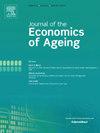Trend in length-of-stay in nursing homes: Evidence from the Netherlands
IF 2
3区 经济学
Q2 DEMOGRAPHY
引用次数: 0
Abstract
For an accurate prediction of the future demand of nursing home care, adequate insight in the trend in length-of-stay (LOS) in nursing homes is required. Almost no research has been done on the trend in LOS and its determinants. We used individual data on nursing home use for the entire Dutch population combined with information on age, gender, cohabitation, care needs, and date of death. Our final sample consisted of 433,377 individual nursing home admissions over the period 2012 through 2022 in the Netherlands. Although the average age at admission was relatively stable, the age distribution got more dispersed over time, because of a simultaneous increase in the share of relatively young older adults in the older population due to the post-war babyboom and the postponement of nursing home admissions to higher ages at the individual level. Furthermore, relatively more men and older adults with higher care needs were admitted to a nursing home. We performed a survival analysis to calculate the expected LOS. We decomposed the trend in LOS into three partial effects: a demographic effect, an effect due to changes in care needs, and a residual time trend. We found that over a period of 11 years, the LOS decreased with 8 %, from 930 days in 2012 to 853 days in 2022. This downward trend is explained by a combination of population ageing (27 %), an influx of older adults with higher care needs (40 %), and other factors captured by the time trend (32 %).
在疗养院停留时间的趋势:来自荷兰的证据
为了准确预测养老院护理的未来需求,需要充分了解养老院住院时间(LOS)的趋势。几乎没有研究LOS的趋势及其决定因素。我们使用了整个荷兰人口使用养老院的个人数据,并结合了年龄、性别、同居、护理需求和死亡日期等信息。我们的最终样本包括荷兰2012年至2022年期间入院的433,377名个人养老院。虽然入院的平均年龄相对稳定,但随着时间的推移,年龄分布变得更加分散,因为战后婴儿潮导致相对年轻的老年人在老年人口中所占的比例同时增加,而且在个人层面上,养老院入院的年龄推迟到更高的年龄。此外,相对而言,更多的男性和老年人有更高的护理需求被送入养老院。我们进行了生存分析来计算预期的LOS。我们将LOS的趋势分解为三个部分效应:人口统计学效应、护理需求变化的效应和剩余时间趋势。我们发现,在11年的时间里,LOS减少了8%,从2012年的930天减少到2022年的853天。造成这种下降趋势的原因是人口老龄化(27%)、有更高护理需求的老年人的涌入(40%)以及时间趋势所反映的其他因素(32%)。
本文章由计算机程序翻译,如有差异,请以英文原文为准。
求助全文
约1分钟内获得全文
求助全文
来源期刊

Journal of the Economics of Ageing
Multiple-
CiteScore
4.10
自引率
4.50%
发文量
46
审稿时长
49 days
期刊介绍:
The Journal of the Economics of Ageing (JEoA) is an international academic journal that publishes original theoretical and empirical research dealing with the interaction between demographic change and the economy. JEoA encompasses both microeconomic and macroeconomic perspectives and offers a platform for the discussion of topics including labour, health, and family economics, social security, income distribution, social mobility, immigration, productivity, structural change, economic growth and development. JEoA also solicits papers that have a policy focus.
 求助内容:
求助内容: 应助结果提醒方式:
应助结果提醒方式:


